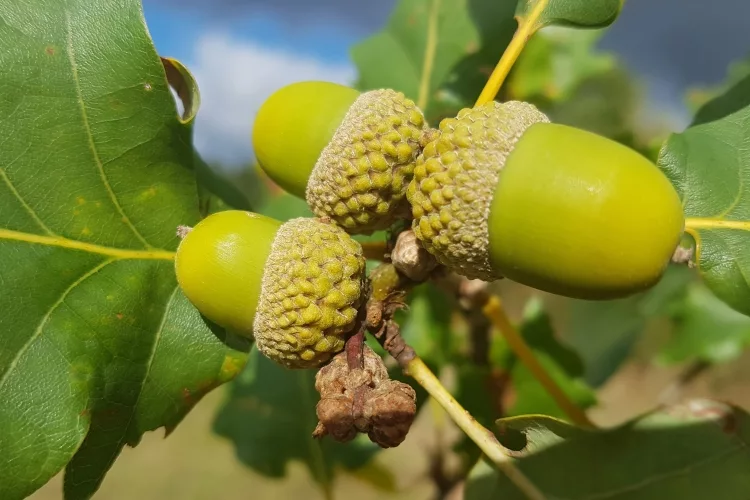reviewed by Christina Lopez
Trees tend to serve various functions or purposes as part of the ecosystem. Trees are the type of plants that mainly receive their support through roots to maintain their posture. The stronger the roots, the better the tree can stand since strong roots help the plant overcome severe weather conditions and prevent soil erosion.
The survival of a plant depends upon its roots as they tend to look for the necessary minerals needed for the plant to live, and to perform such a function, they expand in the soil downwards, creating a deep root system. The 'Great Banyan Tree' is a famous deep-rooted tree found in the Indian Botanic Garden near Kolkata, India.
Contents

The common name for 'Quercus' is 'Oak.' This tree tends to grow gradually, but it reaches up to 3 to 5 meters with strong deep taproots when fully grown. Oak trees are found in the Himalayan Region of India. It is known for its strong grain patterned hardwood.
The Persian walnut tree (scientific name: Juglans regia) is a tree grown in the Jammu & Kashmir region of India. Being a tap root, it requires a well-nourished and drained soil so that it can grow properly and produce delicious walnuts.
Deidara (scientific name: Cedrus deodara) is also found in India's Himalayan region, which also gives it its name Himalayan cedar. Every part of this tree is used for multiple medicinal products and is famously known as the "Wood of gods." It can be used for neurological, respiratory, and skin disorders.
Carya, the scientific name for hickory, is native to Asia, including India. The tree is found in the Assam region of India. The hickory flowers bloom in the spring season and have compound leaves with large nuts. Hickory wood is used for commercial purposes because its wood is very stiff, dense, and resistant to shock.
The Bodhi Tree (scientific name: Ficus religiosa) is a fig tree also famously known as the "Bo-Tree," which means "Tree of Awakening," found at Bodh Gaya in Bihar, India. This tree has special importance and considered sacred since Buddha sat under this tree and attained enlightenment. Being an old tree, it has roots that run deep into the soil and is considered one of India's deep-rooted trees.
In the mahogany family Meliaceae, Azadirachta indica, commonly referred to as neem, nim tree, or Indian lilac, is a tree. In the Azadirachta genus, it is one of two species and is native to the Indian subcontinent. They use the bark, leaves, and seeds to make medicine. The root, the flower, and the fruit are also used less frequently. The leaves have endless medicinal properties.
Any conifer in the Pinus genus of the Pinaceae family is a pine. Pines are some of the world's best-known trees. The timber trade has tremendous economic significance and is easily recognizable due to their distinctive cone-shaped growth type and needle-like leaves. Many of them are found in North America, China, South-East Asia, Russia, and Europe.
Mangifera indica is a native of the Indian subcontinent where it is indigenous, generally referred to as mango. One of the tropical world's most essential and widely cultivated fruits belonging to the chase nut family. Mango trees are deep-rooted plants that in the countryside may become large specimens.
MonoonLongifolium, also widely recognized by its synonym Polyalthia Longifolia, is the false Ashoka. It is found in areas of southern India. Because of its similarity to the Mediterranean Cypress, it became popular in British India, and because the high, straight trunk made it suitable for ship masts.
Commonly known as the Arjun tree, Terminalia Arjuna is a deciduous riparian tree native to India and present in Pakistan, Sri Lanka, Myanmar, and some other Asian countries. They use all parts of the plant, usually as a milk decoction.
In the flowering plant family Myrtaceae, SyzygiumCumini, commonly known as Malabar plum, is an evergreen tropical tree and is favored for its fruit, timber, and ornamental value. Jamun is a slow-growing tropical tree native to India that has a well-defined tap root system, making it one of India's deepest-rooted trees.
Portia tree; flowering plant belonging to the mallow family, Malvaceae, is Thespesia populnea, commonly known as the Indian tulip tree. It is a tree widely found in Tamil Nadu villages and on the world's coasts. Deep roots of portia tree help it to survive without water for quite some time.
The Sal Tree, Shorearobusta, is one of India's largest deciduous trees. The tree is endemic to the sub-continent of India. There's hardly a leafless salt tree. It is said that the tree produces good quality timber.
In the bean family Fabaceae, Delonix regia is a flowering plant species. The deciduous and dicot tree has an extensive taproot system with an invasive growth habit. It is noted during summer for its fern-like leaves and flamboyant display of orange-red flowers.
In India, the two most commonly planted eucalypts are Eucalyptus Tereticornis and Eucalyptus hybrid. Due to their deep root system, the species have spread to most parts of the world, largely because of their flexible existence and their ability to live without water conditions.
India's biodiversity is varied and thick due to its tropical climate, soil, landscape, peninsular shape, and plentiful water bodies found across the region. These factors have helped many deep-rooted trees to grow in India.
Despite the many barriers that pave the way to a realistic understanding of deep rooting functions, it is predicted that increased awareness of the deep rooting characteristics of several plants and crops would have a direct and tangible effect on how we handle natural and cultivated ecosystems in the relatively near future.
15 Plants for Terrace Gardening in India {Rooftop Farming}
 |
 |
 |
 |

About Christina Lopez
Christina Lopez grew up in the scenic city of Mountain View, California. For eighteen ascetic years, she refrained from eating meat until she discovered the exquisite delicacy of chicken thighs. Christina is a city finalist competitive pingpong player, an ocean diver, and an ex-pat in England and Japan. Currently, she is a computer science doctoral student. Christina writes late at night; most of her daytime is spent enchanting her magical herb garden.
 |
 |
 |
 |
Check These Out
Get new FREE Gifts. Or latest free growing e-books from our latest works.
Disable Ad block to reveal all the links. Once done, hit a button below
 |
 |
 |
 |